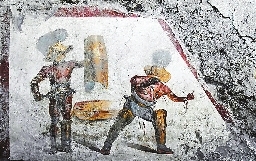
A VIVID fresco depicting an armor-clad gladiator standing victorious as his wounded opponent stumbles gushing blood has been discovered in the ancient Roman city of Pompeii, Italy’s culture ministry said Friday. The striking scene in gold, blue and red was uncovered in what experts think was a tavern frequented by gladiators, who fought each other, prisoners and wild animals for the public’s entertainment. “We do not know how this fight ended. Gladiators were killed or shown mercy,” Pompeii’s director Massimo Osanna said. A “Murmillo” fighter wearing a plumed, wide-brimmed helmet with visor, holds aloft his large rectangular shield in his left hand, as he grips his short sword in the right. On the ground next to him lies the shield of the defeated “Thraex,” who has suffered deep wounds and is on the point of collapse. “What is particularly interesting is the extremely realistic representation of the wounds, such as the one on the wrist and chest of the unsuccessful gladiator, from which the blood runs, wetting his leggings,” Osanna said. “The Thraex is gesturing with his hand, possibly asking for mercy,” he said. The fresco — which measures 1.12 meters by 1.5 meters — was found in what excavators believe was a basement room, as the imprint of a wooden staircase can be seen above it. The building was situated not far from the gladiators’ barracks in Regio V, an entire quarter of the site that has recently offered up several impressive archaeological finds but is yet to open to the public. It was most likely a tavern with an upper floor of rooms used either by the innkeeper or by prostitutes, the ministry said. The discovery was made during work to secure an area of the north in the archaeological park under the Great Pompeii Project, launched after years of bad maintenance and poor weather caused a series of wall collapses. Culture Minister Dario Franceschini said the find showed Pompeii was “an inexhaustible mine of research and knowledge for the archaeologists of today and the future.” The ruined city is the second most visited tourist site in Italy, after the Colosseum in Rome. (SD-Agencies) | 
